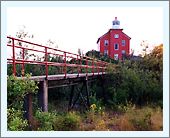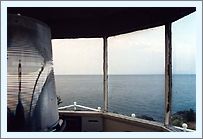 |
 |
|
| Marquette Harbor Light | Seeing The Light |
|
|
|
|
Historical Information After only a decade of operation, the structures were found to be deteriorating rapidly, likely contributing to the succession of five keepers that had been assigned to the station since its establishment. Of these keepers, perhaps the most notable are the Truckey's. Assigned to the station in 1861, Nelson Truckey helped form Company B, 27th Infantry Regiment, Michigan volunteers, and was thus succeeded by his wife Anastasia. Anastasia tended the light for three years until 1865 when she was removed from the position. Likely making her the first of a number of female keepers to work the lakes.
As ore shipments from the bustling harbor increased, the Army Corps of Engineers arrived in 1866, and began construction of a breakwater to further protect the harbor. Starting where Lighthouse Point joined the mainland on its southern side, on its completion in 1875, this wooden crib structure protruded 2,000 feet southward into the bay, and was designed to dissipate the strength of waves before they entered the harbor area. Concurrent to this ongoing harbor improvement, the Lighthouse Board determined that a fog signal at the station would be a vital enhancement to guide vessels into the harbor through the thick weather which frequently enveloped the area. Requesting an appropriation of $4,000 for the project in 1873, Congress allocated the funds for construction that same year, and work began immediately, continuing into 1874 after a break for the winter. With Lighthouse Point being craggy along its entire length, it was determined that the only suitable location for the new fog signal was at the extreme end of the Point. A flat area approximately ten feet above the water was blasted and carved in the rock, and a wood-framed signal building with single 10" steam whistle was erected. With the additional workload represented by the impending activation of the new fog signal, Keeper Samuel Barney arranged to have his brother Albert appointed as the station's first Assistant Keeper, with Albert appearing on payroll records ate the station on April 4, 1874. From the very beginning, the fog signal's location so close to the water at the extreme end of the point created problems for the keepers, as waves crashing against the rocks frequently inundated the fog signal building, and in an attempt to alleviate the problem, a protective wall was built in front of the building in 1875. With the completion of work on the new breakwater the same year, the Army Corps of Engineers constructed a beacon at its outer end, and the tending of this new light was added to the list of duties of the Marquette Keepers. Albert Barney proved to be less successful as an Assistant Keeper than his brother likely hoped, and Albert was removed after only one year of service, to be replaced by Acting Assistant Samuel Torrence on September 29, 1875. While Samuel Barney had distinguished himself during his prior five years service at Grand Island Harbor Range lights and Granite Island, he also proved to be ill-suited for the rigors of operating a first-class shore station with fog signal and breakwater light, and was himself removed from the position at the opening of the 1877 navigation season, to be replaced by newly hired Philip Morgan. The Marquette fog signal quickly established itself as one of the busiest on the lakes, serving not only during fog, rain and snow, but during the numerous forest fires which plagued the area. In the first of many mentions of smoky conditions in the station log books, Keeper Morgan's entry for May 31, 1877 stated in part "Strong wind from the South. Smoky. Washing fog signal and finished painting funnel at fog station. The woods all on fire."
In retrospect, it would appear that the Lighthouse Establishment had an unfortunate propensity for staffing the station with less than competent keepers. By 1882 in its 29 years of operation, ten keepers had either been removed or resigning from the service. To make matters worse, in the 8 short years since the assistant position was added, six assistants had left the station under similar circumstances. At the opening of the 1882 season of navigation, the District Inspector removed both Philip Morgan and Assistant Richard Barney from their positions. In an attempt to provide the station with a keeper of greater competence, Patrick H "Bill" McGuire was selected as the station's new keeper. McGuire had served as Keeper at Thunder Bay Island since March 1874, with his wife Catherine serving as his Assistant. Since the Thunder Bay station had been outfitted with a fog signal in 1871, McGuire and his wife appeared to have the qualifications needed to make the Marquette station "click." The McGuires arrived in Marquette on May 1, and found the stationed abandoned and in complete disarray, with McGuire made the following first entry in the station's log book: "Keeper Bill McGuire & Family arrived in Marquette from St. Ignace on the cars at 2 o'clock PM. Came to the light -house. Found Mr. Morgan & family absent. Got possession of the station on the 5th & found it in a bad and dirty condition." That following year, Supervisor Miller arrived with a work crew to replace the floors in the station's kitchen, built a porch on the rear of the dwelling, and constructed a storm house to protect the main lighthouse entry door.
With the station being located so close to the bustling city, fine summer days always found large numbers of visitors on Lighthouse Point, strolling the beach and holding picnics on the grounds. Sundays were normally considered a virtual "day off" from mundane housekeeping chores beyond tending the light and fog signal as needed. Lighthouse regulations specified that "Keepers must be courteous and polite to all visitors and show them everything of interest about the station at such times as will not interfere with light-house duties." Thus, the McGuires frequently found themselves busier on Sundays than any other, as they answered visitor's questions and provided tours around the station. In 1890, the United State Life Saving Service decided to build a life saving station in Marquette, and with Federal ownership of the full extent of Lighthouse Point, it was natural that new station was located next to the lighthouse on the harbor side of the point. The station was placed into service on May 9th, 1981 with a crew of 8 surfmen serving under Captain Cleary, who was placed in charge of the new station. Also that year, the sea wall in front of the fog signals was thoroughly repaired and a house was built to protect and insulate the water intake pipes for the fog signals. For reasons that we have yet been unable to determine, Patrick McGuire was removed as the keeper of the Marquette Light Station on April 19, 1893. McGuire was replaced by William H. Wheatley, who after signing on as Acting 2nd Assistant on Huron Island for a year in 1882, had been quickly promoted, spending the previous nine years as Keeper of the Green Island and Granite Island light stations. A new city water plant was constructed at the foot of Lighthouse Point in 1895, and with such a ready supply of pressurized water in close proximity, the keeper's dwelling was connected into the system. Prior to this time, the Assistant Keepers lived in rented quarters in town, and that September, construction supervisor James Smith arrived from Detroit, and with the assistance of a hired local carpenter began the work of converting the station's barn into a dwelling for the Assistant Keeper. With the construction of the first ore dock in Presque Isle Harbor by the Lake Superior and Ishpeming Railroad in 1896, the Army Corps of Engineers built a timber breakwater to provide protection for the new dock. To mark the end of this breakwater, a simple pole with a lens lantern was installed, with the tending and maintenance of this new aid added to the Marquette Keeper's list of responsibilities. Thus, on a daily basis either Wheatley or his current Assistant Henry Baker would have to check the lantern every night to ensure that it was illuminated, and make frequent trips in the station boat to adjust and repair it whenever it's light was found to be deficient.
On a fine Spring morning on April 30, 1898, Keeper Wheatley and his friend William Braidon decided to take the station sail boat fishing off the Little Garlic River. Caught in a squall off Little Presque Isle, their small craft capsized around 2.30 in the afternoon. While Braidon managed to make his way to shore, Wheatley was not so fortunate. Captain Cleary immediately went to the rescue with his crew, and while they found the boat floating upside-down in the water about three miles from the river, they were unable to locate Keeper Wheatley's body. The Lifesaving crew stayed out all that night, dragging the area to no avail. While a number of other boats joined in the search over the subsequent eight days, the body could not be found, and the search was abandoned. Wheatley's body was finally found washed-up on shore near the river mouth on May 21, and he was buried the following day. Assistant Henry Baker took over the station until the arrival of Keeper Robert Carlson on May 28. Carlson arrived in Marquette after two years as Assistant on Outer Island, and five years as Keeper of the Michigan Island Light. The day after moving into the dwelling, one of the Carlson girls was playing on the rocks on Lighthouse Point, when she slipped and broke her arm. While Carlson indicated in the station log that he was concerned that the break was severe enough that it would likely result in the girl having a stiff arm for the rest of her life, he never mentioned that matter again. Captain Cleary and Keeper Carlson appear to have established a close working and personal relationship, as they frequently went fishing and boating together, and eventually ended up sharing ownership in a steam launch in which they took great pride in maintaining in tip top condition. Carlson was evidently an accomplished woodworker, as over the years he would undertake a number of improvements around the station, built a number of boats, and oversee the repair of both the Stannard Rock and Granite Island station boats.
While one might assume that electrification would have made Carlson's life considerably easier, this was not entirely the case. The quality of the electric power in the those early days was extremely poor, and with frequent blackouts Carlson and Assistant Henry Baker were forced to make frequent trips out the breakwater to place the old kerosene lamp in the beacon until the power was restored. The advent of the new century saw one of the coldest winters on record, with the water intake for the City waterworks becoming frozen solid on New Years Day. Good friends with the waterworks superintendent, Carlson worked for the next ten days in bone chilling winds attempting to thaw the pipe with salt and fires before restoring the flow of water to the city just in time for a fire alarm to called-in. With no abatement in the chilling temperatures, the intake froze solid again two days later, and Carlson was back on the job for three more days before once again restoring the flow. Continued .....................Click here to go to next page |